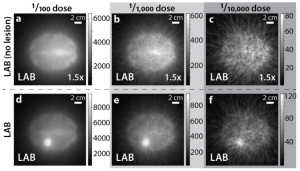by
John R. Fischer, Senior Reporter | January 31, 2024

New PET detectors in development at the University of Chicago could cut radiation exposure in PET scans by a factor of 1,000.
The integration of newly developed detectors in PET scanners has the potential to reduce radiation dose by a factor of 1,000 — equivalent to the level of exposure found on a transcontinental flight.
At the Polsky Center for Entrepreneurship and Innovation at the University of Chicago, researchers designed the component, which they dubbed the frugal tile, to be an evolved form of Large Area Picosecond Photodetectors (LAPPD) that measures the arrival of photons and other charged particles in picoseconds (a thousand-billionth of a second), making time resolution more precise and in turn, creating less need for as high of a dose rate.
The frugal tile also scales sensitivity five times higher for better image quality to detect conditions earlier and with more accuracy, all within a reduced scanning time frame, which allows for more patients to be seen in one day. Additionally, these detectors eliminate the entire system of crystals and photodetectors used in traditional PET detectors, which could potentially cut the average $2 million price tag for such a scanner in half.



Ad Statistics
Times Displayed: 365845
Times Visited: 7102 Quality remanufactured Certified Centrifuges at Great prices! Fully warranted and backed by a company you can trust! Call or click for a free quote today! www.Centrifugestore.com 800-457-7576
"In PET scanning, these detectors have higher resolution and sensitivity, so they extract more information from each gamma ray leaving the patient's body. This significantly reduces the required radiation dose for patients, as fewer gamma rays are needed to gather the same information, reducing the dose to the patient and increasing image quality," Henry Frisch, Professor at the University of Chicago’s experimental High Energy Physics group, told HCB News.
Smaller doses do not decay and expire as fast during transit, allowing them to be sustained longer during transit. By reducing the dose, the detectors expand the geographic use of PET scanners and eliminate the need for them to be located near sources of radioactive material. This makes them more accessible to providers in rural areas, third-world countries, and other underserved and low-resource locations worldwide, according to John Hruska, a second-year student at the Chicago Booth School of Business, who is helping the researchers determine the best approach for commercializing the detectors.
They are also designing a prototype detector to demonstrate these capabilities with a physical device. Once built, the researchers say they will either commercialize it by incorporating the detectors into existing manufacturers' PET scanning systems to increase performance or design a new system around the new detectors.
"The theoretical dose reduction is significant enough that it could change the paradigm of how/when PET scans are used in the clinic," Ben Cox, manager of intellectual property and technology development at the Polsky Center, told HCB News.
The project is being financially supported by the Polsky Center’s Proof-of-Concept Fund, which supports prototype development, commercial feasibility tests, and other research activities for making technology safer to develop.
Along with the detectors, the university is working with the Fermilab microelectronics group to design a chip technology capable of producing an inexpensive, highly usable readout of scan data. This project is supported by the University of Chicago Joint Task Force Initiative, a cross-institutional collaboration launched in 2018 to support Argonne and Fermilab.

